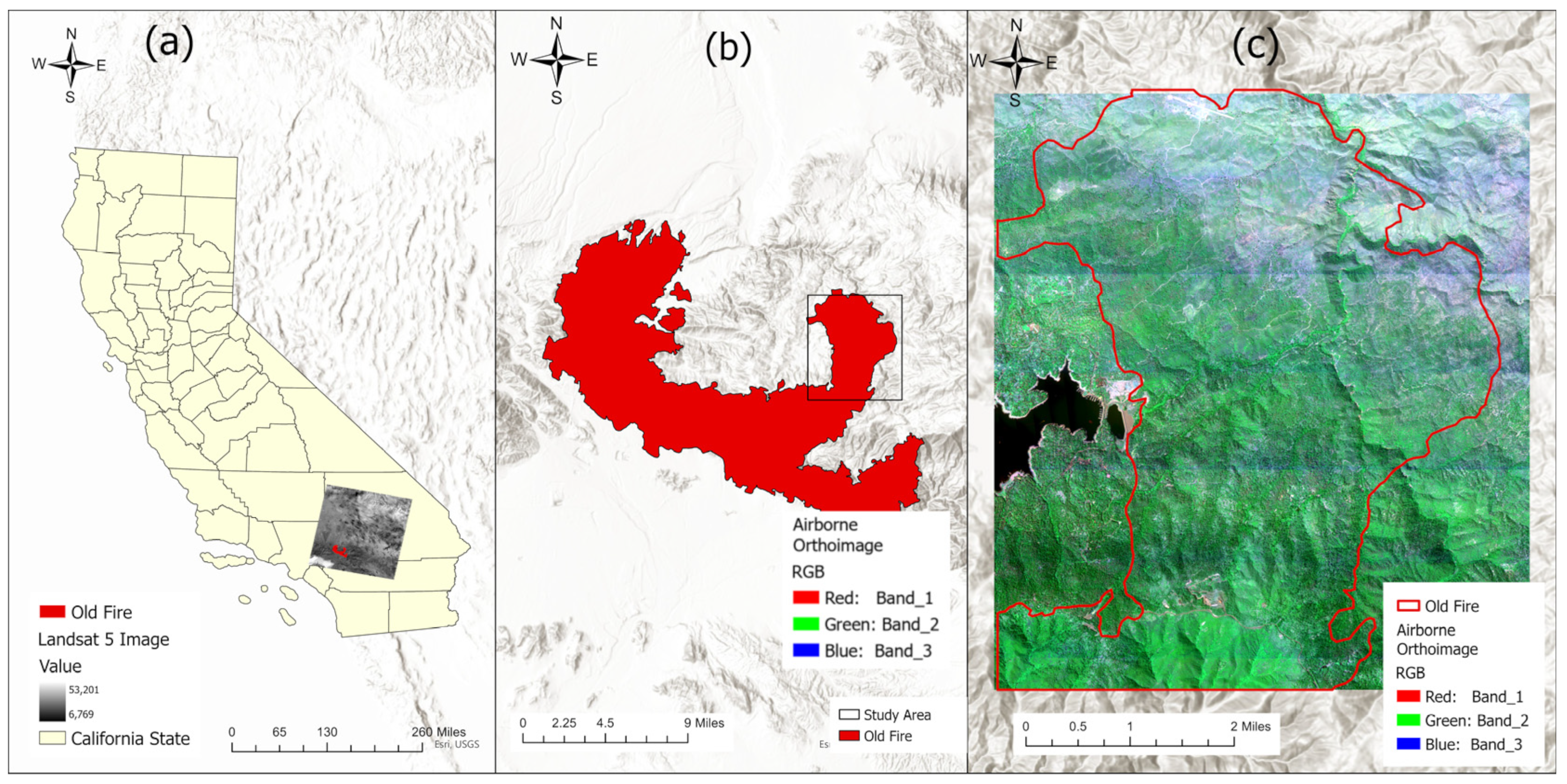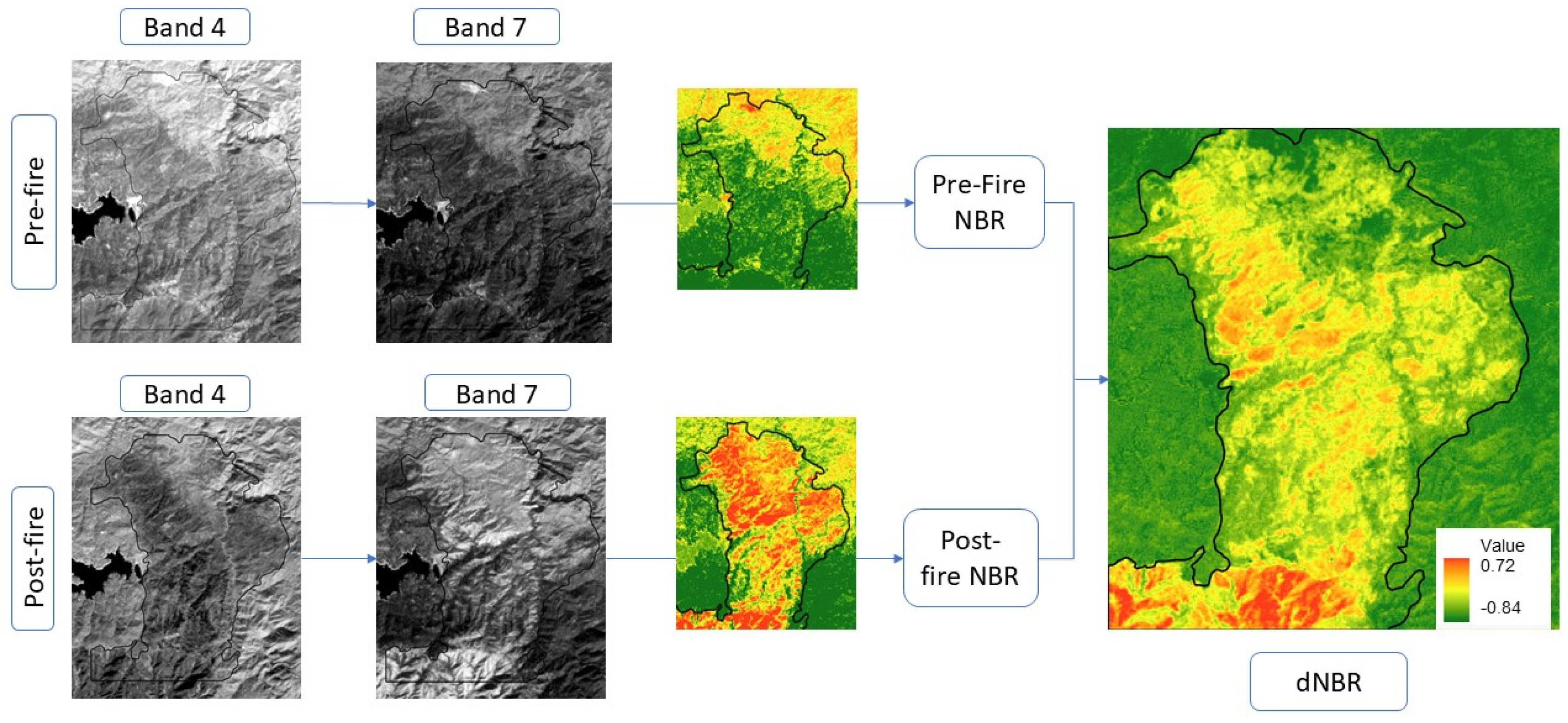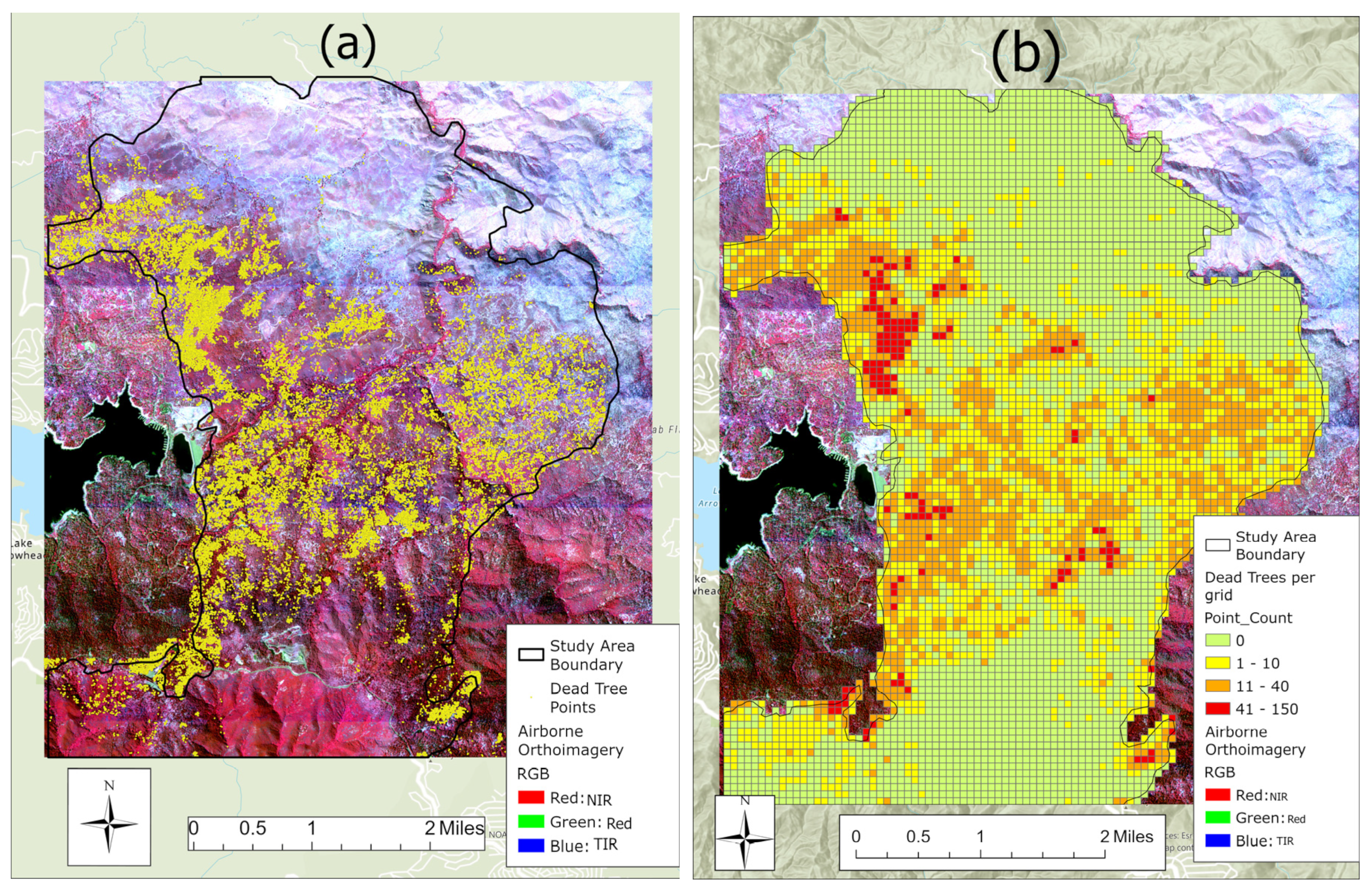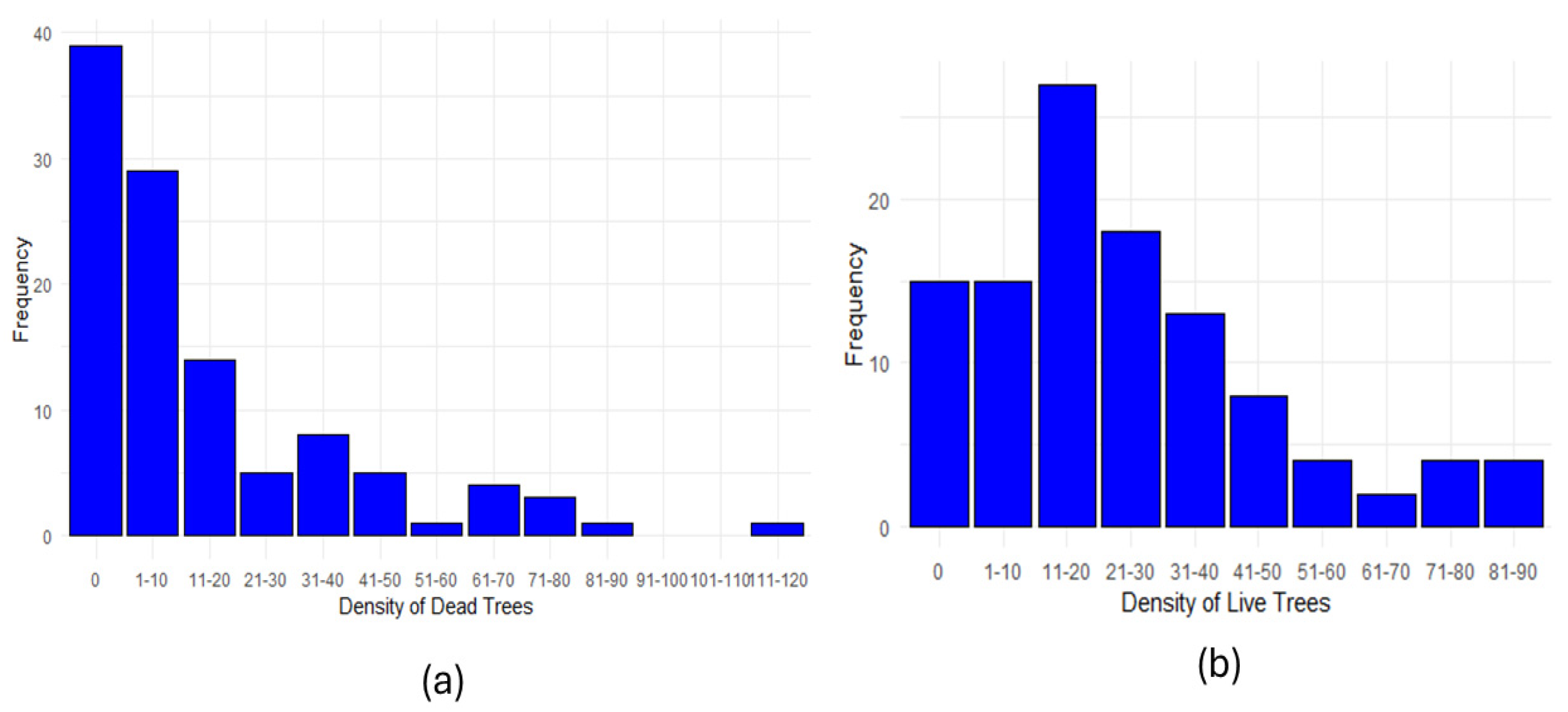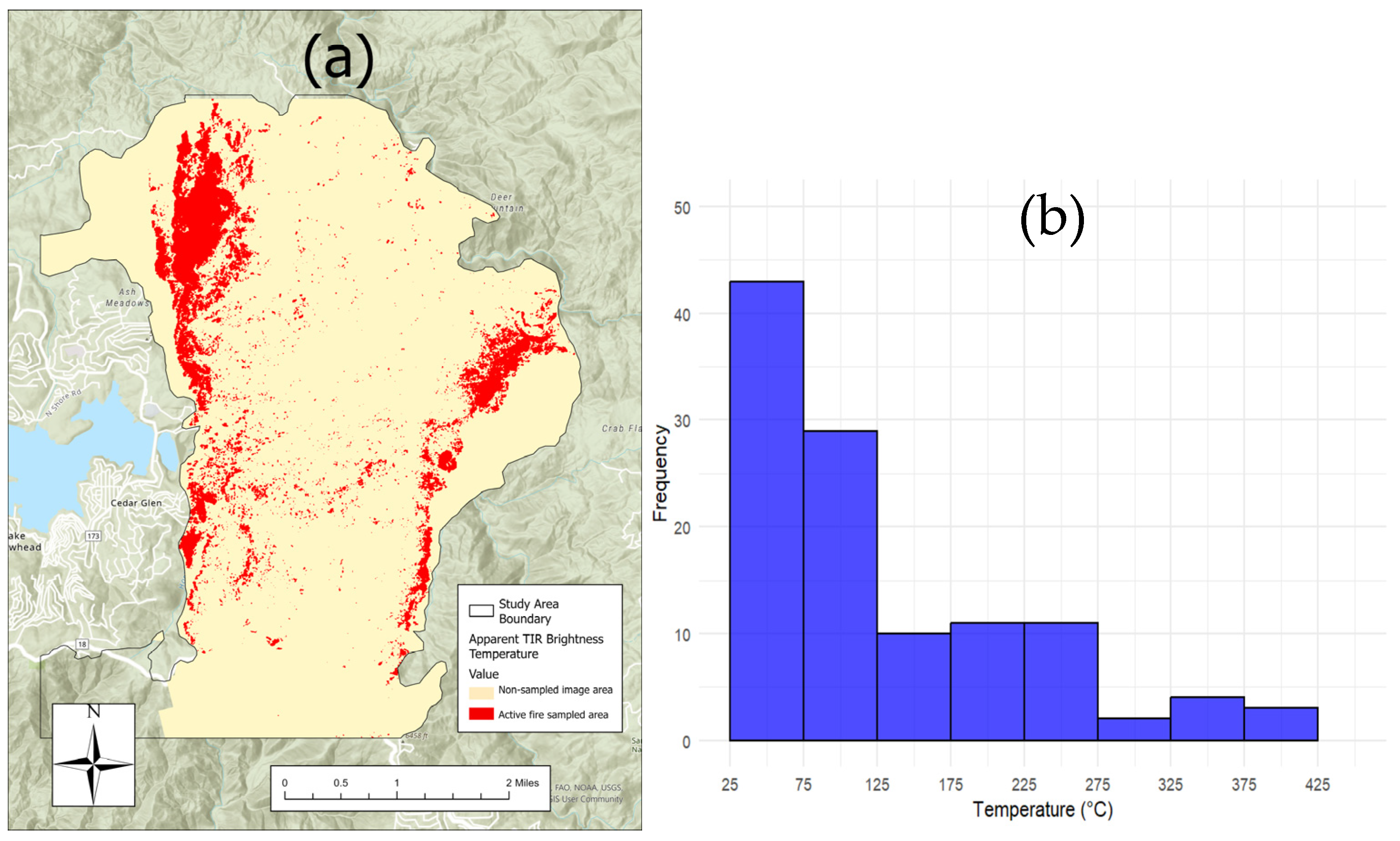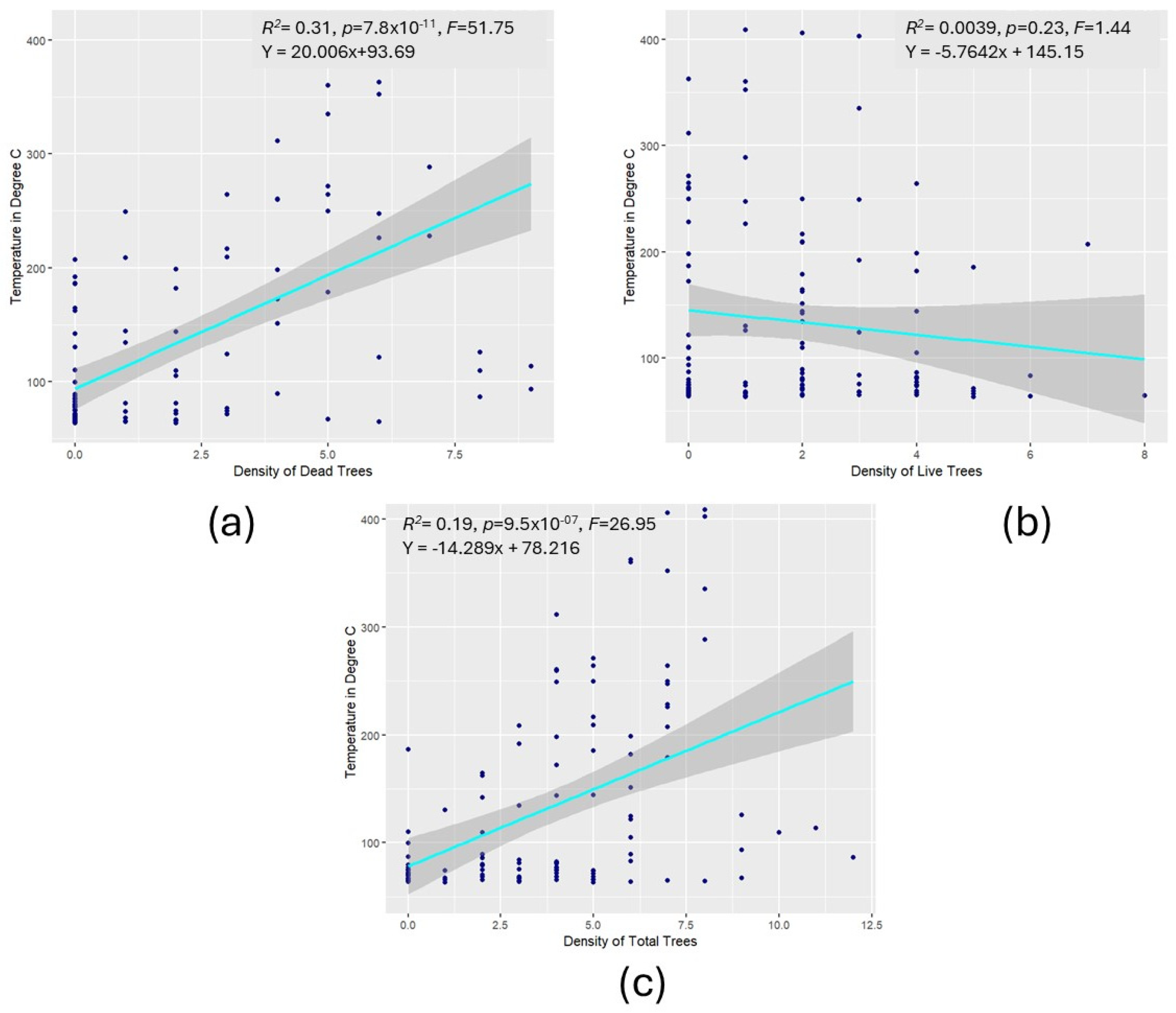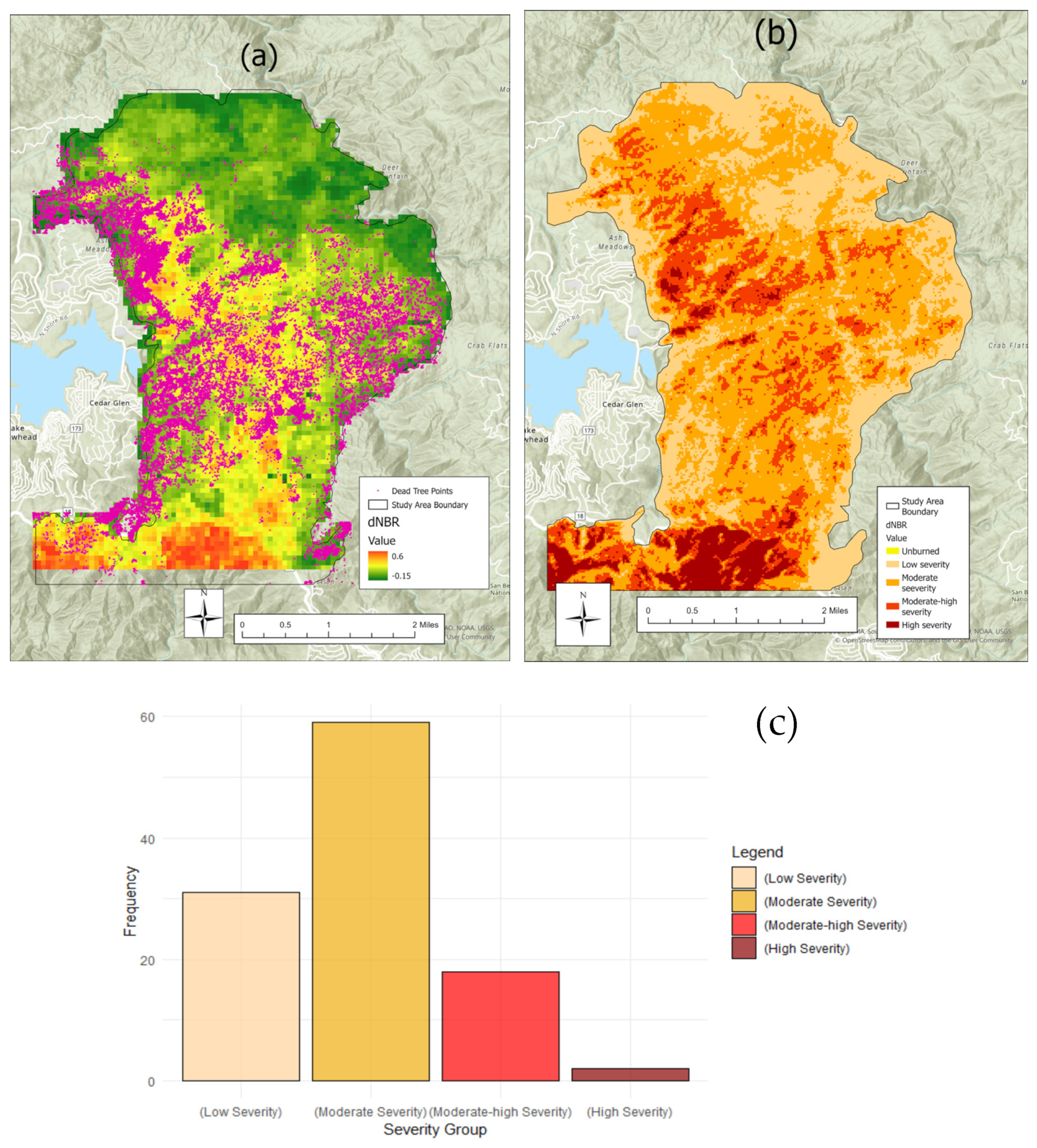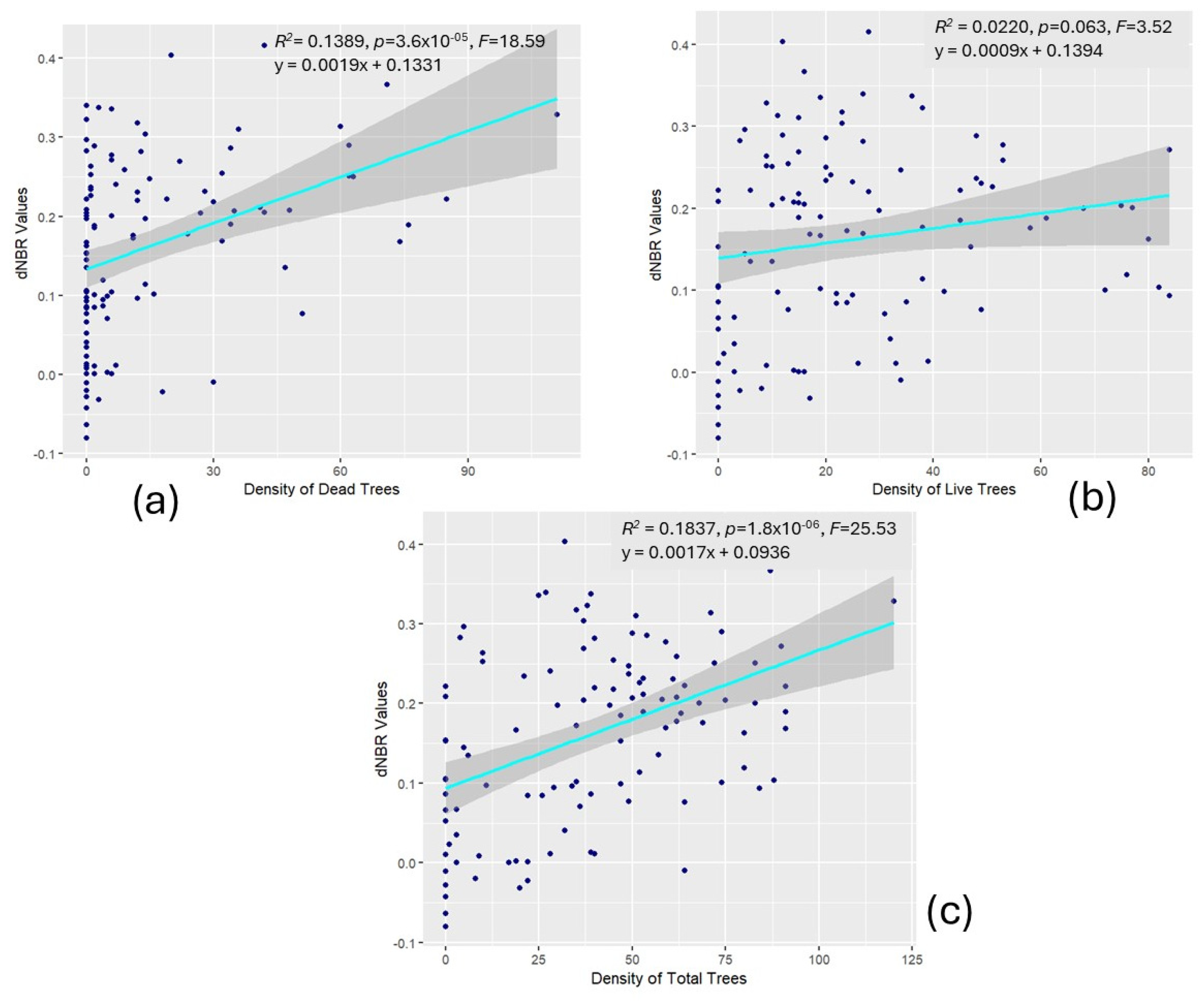1. Introduction
Pre-fire tree mortality refers to the dieback of trees prior to a fire primarily due to drought, insect infestation, thunderstorm, or disease [
1,
2]. The dry fuel loads from standing dead trees can contribute to large wildfires by increasing dead biomass in the forest [
3]. Pre-existing dead trees also influence fire behavior and subsequent burn severity. Moreover, dead trees act as ladder fuels, which can be responsible for spreading the fire from the ground to the tree canopy [
4]. Dead fuel loads can also influence fire spread by enhancing the ignition of spot fires [
5]. Petropoulos and Islam (2017) noted that the volume of flammable material and the arrangement of fuel can increase fire spread and severity [
6].
Wildland fires are common in southern California landscapes due to its seasonally dry, semi-arid climate; mountainous topography; and flammable vegetation [
7]. Keeley (2009) stated that the wildfires in Southern California cause great damage to personal safety and assets [
7]. The spread of human settlement near and within the fire-prone vegetation of the wildland urban interface and the excessively long duration of droughts are also responsible for the vulnerability of southern California residents to fire [
8]. Most wildfires in the southern California region are ignited by human activity such as power line failure, arson, camping, etc. [
9].
The San Bernardino National Forest suffered a widespread mortality event after prolonged drought in the early 2000s [
10]. Subsequently, three major fires within southern California started on 25 October 2003, burning thousands of hectares of lands and homes in southern California: The Old Fire, the Cedar Fire, and the Grand Prix Fire [
11]. Lake Arrowhead, Crestline, the city of San Bernardino, and Running Springs were threatened by the Old Fire (USFS, 2003). Some have speculated that the behavior of the Old Fire may have been influenced by the substantial presence of dead trees [
11]. While Bond et al. (2009) assessed the relationship between tree mortality and burn severity derived from remotely sensed data, vegetation characteristics such as types, dominant tree, canopy cover, and topographic features like slope and aspect, they did not map tree mortality at the individual dead tree level and used crude estimates of dead tree density based on real-time visual estimates from spotters in helicopters [
12]. In this paper, we use a hybrid automated–manual approach of dead tree mapping. Moreover, the Bond et al. (2009) study did not assess the influence of tree mortality of fire behavior, whereas we analyze influences on fire intensity. We also assess potential linkages of tree mortality to fire intensity based on remotely sensed data and post-fire burn severity analysis [
12].
Investigating the role of dead tree cover on fire behavior and burn severity requires data collection before, during, and after a fire event, which can all be gathered with different methods of remote sensing. Remote sensing offers efficient means of collecting suitable data for pre-fire tree mortality assessments [
13]. Specifically, high-spatial-resolution airborne imagery is an effective data source for detecting individual trees and the canopy of groups of trees to assess pre-fire dead tree cover [
14]. The FireMapper thermal imaging radiometer of the USDA Forest Service captured high-resolution airborne imagery during the October 2003 fires in southern California. Extensive forest mortality due to bark beetle infestation and droughts were observed from the imagery from the Old and Cedar fires [
11].
During the wildfire, aerial thermal infrared (ATIR) images provide relevant information about active wildfire that is useful to study the dynamics of wildfire behavior, such as fire intensity and rate of spread [
15]. Fire intensity is known as the release of energy at the fire front, per unit time per unit length [
7,
16]. Burn severity is defined as a measurement of fire severity on the ground, particularly changes in the physical and ecological environment caused by fire activity [
17]. Normalized burn ratio (NBR) and delta normalized burn ratio (dNBR) are useful spectral indices for mapping the extent of the burned area and estimating burn severity using pre- and post-fire imagery [
7]. In particular, a combination of pre- and post-fire Landsat 5 TM+ and aerial multispectral orthoimages is commonly used to generate NBR and dNBR images that can be classified into different categories of burn severity using established methods [
18]. High-spatial-resolution (1.6 m) aerial orthoimages including visible, near infrared (NIR), shortwave infrared (SWIR), and thermal infrared (TIR) were provided by collaborators in the USDA Forest Service. This dataset offers pre-, during, and post-fire images which were captured, processed, and made available for this study, providing a unique opportunity to study all phases of a wildfire.
In this study, we used high-spatial-resolution (1 m) airborne multispectral orthoimages to detect and map tree mortality for a portion of the San Bernardino Mountains, where the Old Fire burned in 2003, and analyzed the spatial association of dead trees with the intensity and burn severity of fire. We used brightness temperature values from ATIR images as a proxy for fire intensity. We mapped patterns of burn severity based on the satellite-derived NBR and dNBR index. To explore the role of dead tree cover on fire intensity and burn severity, we examined the spatial association of pre-fire dead tree density (number of trees per unit area) derived for 90 m × 90 m grid cells with ATIR-derived fire intensity (7 m spatial resolution) and Landsat-derived burn severity (30 m spatial resolution) using spatial analysis and statistical methods.
This study was built on the hypothesis that the presence and density of pre-fire dead trees increased the fire intensity and post-fire burn severity of the Old Fire, focused on a forested area east of Lake Arrowhead [
11]. The research will enhance a better understanding of fire management practices in future wildfire scenarios.
Within the context of the 2003 Old Fire, this study aimed to address the following questions:
How were pre-fire dead trees spatially distributed throughout the San Bernardino Mountain study area prior to the fire?
Is fire intensity, as represented by ATIR apparent brightness temperatures, spatially associated with pre-fire dead tree density?
Is burn severity, as represented by Landsat 5 TM dNBR imagery, spatially associated with patterns of pre-fire dead trees? How does the burn severity vary in areas with higher numbers of dead trees compared to areas with lower numbers of dead trees?
2. Methods
This study is primarily based on airborne imagery collected by the USDA Forest Service Pacific Southwest Research station before, during, and after the Old Fire in 2003 in the San Bernardino Mountains. To address the research questions, airborne multispectral imagery was used for mapping pre-fire dead trees, ATIR images for active fire intensity analysis, and post-fire Landsat data for determining post-fire burn severity. We analyzed the spatial distribution of fire intensity and burn severity with pre-fire dead trees with scatter plot and regression analysis. A flowchart for the general research approach and procedures is shown in
Figure 1.
2.1. Study Area
The study area for this research corresponds to parts of the lands which burned during the Old Fire, as shown in
Figure 2. Beginning on 25 October 2003, the Old Fire burned about 23,000 ha in the San Bernardino Mountains until 5 November 2003 [
19,
20]. It burned during high wind and low relative humidity conditions of a Santa Ana weather event, which is common for fall fires in the southern California region [
21,
22]. The Old Fire burned a substantial amount of chaparral and woodland vegetation in low and high elevated areas, respectively [
20]. The study area is mainly composed of coniferous forest, chaparral, black oak and canyon oak woodlands, and riparian vegetation. The study area has a Mediterranean climate which results in hot, dry summer and wet winter seasons [
1].
The San Bernardino National Forest contains a wide array of ecosystems and vegetation communities including montane mixed conifer forests, which are dominated by tree species such as Jeffrey pine, white fir, sugar pine, canyon live oak, and black oak [
1,
23]. It hosts diverse species of plants and animals, particularly deep-rooted chaparral shrubs along with mixed conifer forests in higher-elevation areas [
12,
19]. Conifer forests occur at elevations between 1400 and 2600 m and occupy a range of 57,000 ha in the San Bernardino Mountains [
24]. Fire return interval (FRI) in the Old Fire burn area typically varies from 10 to 35 years. However, the area has experienced significant departure from the FRI historically, with approximately 55% of the forest burning either more or less frequently. The coniferous forests in the study area experiencing low-severity fires every 0–35 years are burning less frequently at present, which increases their vulnerability to severe fires [
25].
2.2. Data Collection
High-spatial-resolution airborne imagery was collected prior to and following the Old Fire, processed, provided as orthoimage mosaics by USFS PSW Research Station, and used to detect and map dead trees for this study. The red NIR bands of the orthoimages have a spatial resolution of 1.6 m. These four waveband aerial frame images were taken from November 2002 to September 2003 (prior to the Old Fire), October 2003 (active fire), and November 2003 (after the Old Fire) in the visible red (0.62 to 0.69 μm), NIR (0.82 to 0.89 μm), SWIR (1.6 μm), a narrow TIR (11.4 to 12.4 μm), and a wide TIR (8.1 to 12.5 μm) bands. The images were processed using Agisoft Metashape software version 2.1.0 to create a digital surface model and orthoimages. Details of image data are provided in
Table 1.
TIR image data were collected during the Old Fire using the USDA Forest Service PSW FireMapper sensor covering an area east of Lake Arrowhead where active burning was taking place. The FireMapper includes two TIR sensors, IR3 and IR4. This Space Instruments-manufactured sensor provides image dimensions of 327 × 205 and an image radiometric encoding of 14 bits. The TIR image collection was conducted over a four-hour window during active fire. The image collection encompassed 21 flight passes that were further divided into four sets depending on their time of flight. The comprehensive set of active fire data includes all individual orthorectified frames and mosaics of the 21 passes. The USDA Forest Service also provided post-fire multispectral airborne orthoimages which served as an additional layer to facilitate the burn severity analysis conducted using Landsat data. Specifics of the TIR data collection and imagery characteristics are summarized in
Table 1.
Landsat 5 Thematic Mapper data were acquired and used to derive spectral indices and maps of burn severity. They were selected for their widespread availability, extensive temporal duration, and large area coverage. Moderate-spatial-resolution (30 m) Landsat imagery was acquired as georeferenced surface reflectance data that were used to classify and map burn severity. Landsat 5 images from Landsat Level 2, Collection-2 were collected for this study from the United States Geographical Survey (USGS) website ‘Earth Explorer’ (
https://earthexplorer.usgs.gov/, accessed on 15 April 2023). Pre-fire and post-fire images with cloud-cover < 20% were downloaded. The study area falls within the worldwide reference system (WRS) path 040 and row 036 (
Figure 1).
2.3. Dead Tree Mapping
The process of visually identifying and digitizing dead tree locations was conducted using a hybrid automated–manual approach that yielded a detailed and accurate dead tree map. A deep learning model for detecting dead trees was developed with ArcGIS Pro version 3.1 using the airborne orthoimages as input data and individual dead trees as the training sample. The model was trained using SSD, with a batch size of 8 and 100 epochs. This deep learning routine uses a convolutional neural network (CNN) classifier trained on samples of dead trees. It identified locations of dead trees, delineated by bounding boxes. Another dataset of dead tree distribution was generated by the USFS using Object-Based Image Analysis (OBIA). The same multispectral airborne orthoimages were input to the CNN model, and the output layer was used as an additional resource for supporting our visual image interpretation.
To achieve precise detection and mapping of the locations of pre-fire dead trees, manual mapping and digitization techniques were implemented. ArcGIS Pro was utilized as the primary tool for this image analysis. Airborne multispectral images captured 18 September 2003 and processed to create orthoimagery were used as the base image. Four single-band images were layer-stacked to form a composite image including the red band, NIR, SWIR, and TIR bands and used as the primary basis for interpretations and mapping, exploiting the high separability between live and dead trees. The study area was divided into discrete square grid cells of 90 m × 90 m to support systematic mapping of dead and live tree density. A GIS layer of the grid cells and study area boundary was integrated with Google Earth Pro version 7.1.8 images captured before the fire in October 2003. These higher spatial resolutions (between 15 m to 15 cm) were used as another source to support interpretations from the USFS airborne orthoimagery to exploit its very high spatial resolution. High-spatial-resolution (1.6 m) digital elevation model and digital surface model (DSM) data provided by the USFS for the study area were utilized to create a normalized DSM (nDSM) of the study area which illustrated the heights of the tree canopy in the image. This layer provided another support for the manual mapping approach of the dead trees. Each grid cell was meticulously analyzed side by side with the true-color Google Earth, nDSM, and false-color composite USFS images to interpret and digitize the dead tree positions as a point shape file. Similar techniques were followed for sample plots from within the study area to map live trees using manual interpretation and digitization.
We mapped and calculated the number of live trees as a point shapefile with a manual mapping approach for a selection of sample grid cells. The live tree layer was also used in the statistical analysis as well as total trees for those samples.
2.4. Fire Intensity Mapping
To assess fire intensity during active burning, ATIR image data were collected, processed, and made available by our USFS collaborators. Twenty-one ATIR orthoimage mosaics stemming from four sets of image collection passes were generated. By combining each collection pass from four sets, composite mosaics were produced by the USFS. The FireMapper data were calibrated to upwelling radiance at the sensor in units of W m−2 μm−1 sr−1, which were linear on the instrument’s digital number (DN). The FireMapper sensor was stabilized with ambient (aircraft) temperatures during the data collection. Using the estimates from the calibration and the Planck’s function, the DN values associated with selected temperatures were calculated. However, the analysis of dead trees was performed based on the digital number values which represented the ground temperature during the active fire. The maximum apparent brightness temperature values were extracted from the four image layers, and the maximum values were recorded. The values ranged between 1 and 8577, and the hotter pixel values representing burning areas were ≥4200 (>63 °C).
2.5. Burn Severity Mapping
Satellite-derived burn severity mapping is an important tool in the monitoring and assessment of post-fire burn effects [
17,
26]. In particular, normalized burn ratio (NBR) and delta normalized burn ratio (dNBR) spectral indices are discussed in this overview and were employed in this study. NBR is a useful spectral index to map burned area extent and quantify burn severity, such that lower NBR values represent greater burn severity [
17,
26]. Another burn severity metric, dNBR, is calculated as the difference in NBR values between pre- and post-fire Landsat images [
27]. Higher values of dNBR represent higher burn severity. The following equations of calculating of NBR and dNBR for Landsat Thematic Mapper data were developed from different studies and were used in this study [
7,
26,
27].
where:
NIR = near-infrared surface reflectance (band 4 of Landsat 5)
SWIR = short-wave infrared surface reflectance (band 7 of Landsat 5)
NBRpre-fire = normalized burn ratio of pre-fire satellite image
NBRpost-fire = normalized burn ratio of post-fire satellite image
NBR was calculated based on Equation (1) for both pre-fire and post-fire images and was used to calculate dNBR (Equation (2)). dNBR values were classified into unburned, low severity, moderate severity, moderate-high severity, and high severity classes established by Key and Benson (2005) using a threshold-based classifier [
18]. The process is shown in
Figure 3.
2.6. Analytical Methods
The distribution of dead tree density in the study area was analyzed and compared with fire intensity and burn severity distributions. Spatial analyses were conducted based on 21 m × 21 m and 90 m × 90 m grid cells as analytical units, within the domain for which dead trees were mapped. The densities of dead trees within each grid cell were computed using the ‘summary within’ tool provided in ArcGIS toolbox. The zonal statistics tool within the ArcGIS toolbox was used to conduct the averaging and pixel value extraction of the fire intensity variable. We generated two tables of post-fire burn severity measurements including dNBR values and brightness temperature values for each grid size. The tables were joined with the tables consisting of the number of pre-fire dead trees within each grid for both sizes of grids, which resulted in a table consisting of all three elements, number of dead trees, burn severity, and fire intensity, for further comparison. The 21 m grids were used to assess the co-variability of fire intensity and dead trees, and 90 m grids were used for the comparison between burn severity and dead trees.
From the resultant grids with dead tree densities, 111 samples from 90 m grid cells and 113 samples from 21 m grid cells for each cell size were randomly selected for dead tree vs. burn severity and fire intensity analysis. To compile the sample data, we generated random points and extracted the grid values associated with the points in ArcGIS Pro. Sample selections were guided by a minimum distance from other sample cells to minimize the effects of spatial autocorrelation. The minimum distance was established by taking the mapped area and dividing it by the number of samples and then taking the square root to estimate an appropriate separation distance between the samples. For the dead tree vs. fire intensity analysis, a smaller sample size was necessary because the domain of analysis was limited to the zones of active flame front during the FireMapper imaging. The sample separation distance was necessarily smaller to enable a sufficient sample size to be selected for statistical analysis. A separation distance of 500 m was used for sampling the 90 m grid cells while 100 m was used for the sampling of 21 m grid cells. For the TIR pixel values, a threshold of ≥4200 (>63 °C) was selected, which eliminated the comparatively cooler pixels and kept the ones that were hotter and burning during the fire. We assessed the relationship between pre-fire tree mortality and fire intensity as well as burn severity using linear regression in RStudio version 2024.12.1+563 where fire intensity or burn severity were the response variables and tree mortality was the predictor. From this analysis, we generated scatterplots, least square line, regression coefficient, p-value, and f-statistics to determine whether the variables were significantly correlated and, if so, the strength of correlation.
4. Discussion
A substantial number of pre-fire dead trees were mapped in the study area, and they were moderately and weakly co-related with fire intensity and burn severity, respectively. We addressed one of the research questions of this study that pertains to the distribution of pre-fire dead trees in the Old Fire perimeter in San Bernardino Mountains. We also addressed research questions pertaining to the relationship of pre-fire dead trees with apparent TIR brightness temperature and post-fire burn severity. Findings of the statistical analysis elucidate that there is a significant relationship of pre-fire dead trees with fire intensity and a weak but significant relationship with burn severity.
4.1. Distribution of Dead and Live Trees
Pre-fire dead trees mapped using very-high-spatial-resolution (1.6 m) airborne imagery were found to be distributed throughout much of the study area. Tree mortality is attributed to drought and bark beetle infestation in the forest, killing thousands of conifer trees as well as chaparral shrubs [
11]. Bark beetles may attack suitable host trees in proximity of few hundred meters [
28]. This supports the findings that clusters of higher-density dead trees were located within hundreds of meters from each other. A study by Freeman et al. (2017) reported tree mortality in montane mixed conifer forests in San Diego County due to drought and beetle infestation [
29]. Freeman et al. (2017) reported tree mortality occurring in clusters, with peak mortality occurring between 2002 and 2005, which supports our findings that large numbers of dead trees existed in the San Bernardino Mountains during 2003. However, the number of dead trees per hectare estimated in the Freeman et al. (2017) study was much lower than our findings [
29]. The highest number of dead trees found was 10.3 dead trees per ha in 2005 for Palomar Mountain, compared to a maximum of 192 dead trees per ha in our study. This could also be an outcome of the substantial effort to remove dead trees on Palomar Mountain from 2003–2005 [
29].
The majority of the grid cells within our study area prior to the Old Fire had no dead trees. Dead trees were predominantly present in the northwestern part of the study area, located east of Lake Arrowhead. The cells with the highest number of dead trees recorded were also located in this portion of the study area. Five of the grid cells had over one hundred dead trees.
Bond et al. (2009) assessed the distribution of dead trees in the Old Fire and Grand Prix Fire perimeter in 2003 (a much larger areal extent than our study site), with 22 dead trees per ha reported as the maximum, which is substantially lower than our findings of 192 dead trees per ha [
12]. Fifty percent of their study area was found to have no dead trees, which was slightly higher than 43% grid cells for our study.
Live tree density in our study was only estimated for a sample of grid cells in the study area for both 90 m and 21 m grids; the highest number of live trees found per hectare was 108. Freeman et al. (2017) also mapped and analyzed the distribution of live trees per hectare, which ranged from 99 to 273 live trees per ha. We found a weak but significant negative correlation between the numbers of dead and live trees for each grid cell, indicating that areas with higher numbers of dead trees tended to have lower numbers of live trees. This is similar to the findings of Freeman et al. (2017) for the Palomar and Volcan mountains.
The deep learning routine and multispectral imagery used in this study yielded poor estimates of dead tree density, primarily due to the mismatch in image resolution and the deep learning algorithm. Generally, deep learning models built with the ArcGIS Pro are reported to yield accurate tree mapping results for imagery having spatial resolutions of 10–25 cm; the airborne image used in our study has a spatial resolution of 1.6 m. Detected trees from the deep learning model had several false-positive and false-negative detections; despite that, 7501 out of the 38,258 dead trees were correctly detected by the model.
4.2. Influence of Dead Trees on Fire Intensity
The Old Fire started on 25th October, but the ATIR images utilized in this study were taken four days after the fire started. The fire spread was captured by four different imaging passes throughout the day; the active front was moving to the west and north, in a similar location to most of the recorded dead trees for the 21 m sample grids. Although the imaging repeat frequency was low, the four passes enabled the direction of fire spread to be discerned, which was moving in the direction of the Santa Ana winds, to the west. A significant correlation was found between apparent brightness temperature (as a metric for fire intensity) and dead trees with
R2 = 0.31, which means that 31% of the variance in fire intensity can be explained by dead tree density. However, other factors such as topography and wind speed and direction likely influenced the fire intensity as well, which were not addressed in this study. A study in the Sierra Nevada Mountains by Stephens et al. (2022) concluded similarly that pre-fire dead and live tree densities influenced fire intensity [
3]. The tree mortality noted by Stephens et al. (2022) also resulted from drought and beetle infestation effects. The study identified the combination of dead and live tree density as a key influence for increasing fire intensity [
3]. Although we found no significant correlation between fire intensity (brightness temperature) and live trees, a moderate significant correlation (
R2 = 0.19) was found between fire intensity and total trees, which is the sum of dead and live trees in a grid cell. Dead and dry fuel are highly flammable and contribute to the severity of fire [
8]. The lack of water content in dead vegetation makes them highly combustible. The dead fuel combustion then contributes to faster drying out of living foliage as well, increasing fire intensity as a whole [
30]. The age of the dead fuel can also influence the fire intensity, as older fuel can increase fire intensity [
31]. However, much of the drought- and beetle-caused tree mortality occurred just prior to the fire of 2003. Specifically between 2001 and 2004, drought-weakened trees in southern California were susceptible to different species of bark beetle infestation. Mortality in early years contributes to catastrophic wildfires including crown fires.
The relatively high-spatial-resolution TIR imagery used in this research was a composite of four flight passes from different times of the same day. Visual observations on some of the samples containing a higher number of dead trees (8–9 dead trees per sample) showed lower apparent TIR brightness temperature values. This could be a result of the fire already passing through the sampled points when the images were acquired.
4.3. Influence of Dead Trees on Burn Severity
From the linear regression results, the spatial association of burn severity with the pre-fire dead and total trees is found to be moderately significant with R2 values of 0.14 and 0.18, respectively. The correlation is weak, likely because the pre-fire dead and total tree density are not the only factors influencing the burn severity of the fire, but other factors such as topography, fuel characteristics, wind direction, etc. were also present. Moreover, dNBR is an image-derived surrogate for actual burn severity.
Contrary to our findings, Bond et al. (2009) found no evidence of the drought- and pine beetle-caused tree mortality influencing the fire severity of the Old and Grand Prix fires [
12]. They used Landsat TM RdNBR data for the burn severity analysis and studied the entire burned area within the perimeter of both wildfires and divided the burn severity into four categories. However, they found no correlation (
p = 0.88) between the pre-fire dead trees and moderate-severe burned areas. The number of dead trees per ha noted in the Bond et al. (2009) study was much lower than what we observed [
12]. However, their estimates were based on visual estimates from aircraft overflights conducted by the USDA Forest Service, whereas we directly mapped dead tree locations using high-resolution (1.6 m) airborne imagery. Our different study area extents (entire Old and Grand Prix fire perimeter) are another likely explanation for the contrasting results.

